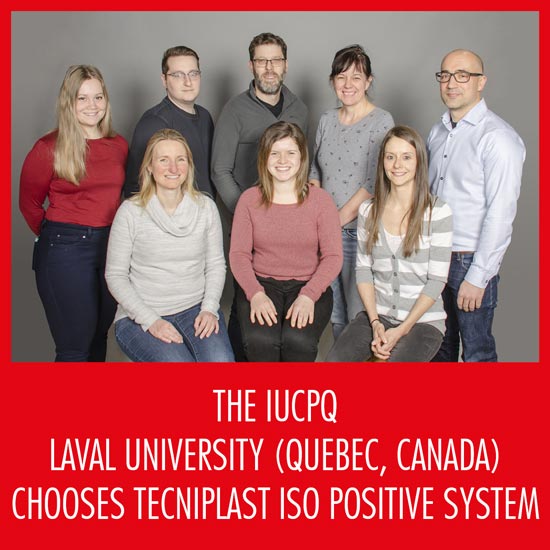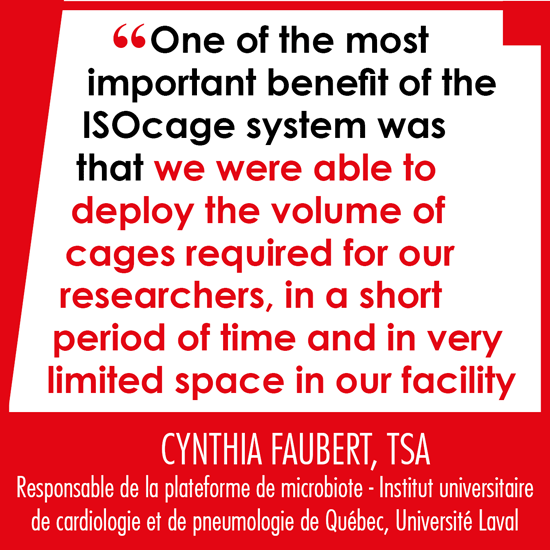
The current version of the Tecniplast website doesn't match your region. Please visit your local website to find information and offerings specific to your country.

The current version of the Tecniplast website doesn't match your region. Please visit your local website to find information and offerings specific to your country.

Panorama meets Cynthia Faubert, TSA
(Responsable de la plateforme de microbiote - Institut universitaire de cardiologie et de pneumologie de Québec, Université Laval)

We see from the paper, that you have chosen the Tecniplast ISO Positive System (ISO CAGE + IBS Station). Can you tell us the alternatives you have taken in consideration and the reason of your choice ?
Our program started with the creation of a Canada Excellence Research Chair (CERC) in the Microbiome-Endocannabinoidome Axis in Metabolic Health, which as its title implied, involved the usage of axenic and gnotobiotic animal models. Based on the projected need of our chair holder, we thus had to accommodate as many housing spaces as possible for housing axenic and gnotobiotic mice in a very limited space available in our facility. We then estimated the number of cages that we could deploy with the ISOcage system as compared with the more conventional isolators. We concluded at the time that a much larger number of ISOcages could be fitted in our two small rooms, thereby increasing the efficient usage of costly animal facility spaces. Moreover, as we were also interested to perform gnotobiotic studies, the possibility to simultaneously house 30 cages / rack, all with mice harboring a different flora, boosting the output potential of our small housing rooms.
Implementing a new technology is a challenge of organization. After the reception of your equipment, what were the steps leading you to your official opening?
It was indeed an important achievement for us. At the time, we did not have much knowledge on the microbiota research field. Our implementation process started by training on how to use the technology, even before the reception of all the components. We had the chance to be put in communication with the University of Toronto. They were already running a germ-free facility with ISOcages for a few months. They generously welcomed us for an intensive two-day training with the complete system, but they also shared their procedures and showed their installations. This visit has been an incredible help for our team and our program. We were able to adapt what we had observed for our needs and prepared our installations for the equipment’s arrival. After the ISOcage system’s installation, we went through a four months’ running in period with SPF mice. This period allowed us to develop our dexterity, but also all the procedures around the housing of animals in the system. Another major thing that we validate during this period was the sampling for our QA program. We wanted to see what kind of sampling could be used to establish the health status of our mice.
Finally, more importantly, this practice time was used to coordinate the work between the QA department and the field activities to be done by the animal health technicians. Organization is key for the global process to maintain an efficient service. Thereafter, being sure we were able to handle mice regularly in the technology, we received our first germ-free mice arrival in June 2017, followed by a second one in January 2018. These animals were still practicing mice for us at this point and our main goal was to keep them germ free as long as possible. At this time, we still have germ-free mice from our very first arrival.
Since that date, we hosted a couple short-term protocols with germfree mice for our principal investigators (PI). Our main challenge this year was a gnotobiotic protocol of 25 cages for a three-month period. This was a major step for us and our platform is officially open since that project, which was September 2018. It took us almost two years to be ready to offer our services, from the training in Toronto to this pivotal point of hosting a gnotobiotic protocol.
The use of this technology implies specific types of protocols and procedures. Have you identified particular SOPs for this system?
Even with a start-of-art technology such as ISOcage system, you need to have specific, constant and precise procedures, because animals are vulnerable to their environment when they are manipulated in the IBS station. We started with what we have learned in our training. However, our procedures significantly evolved with discoveries enlightened by our thorough QA program.. We were able to target flaws in our work technique and modify small details in the manipulations that had great impacts on our animals, but also on the time and human resources needed. Our routine now follows many complementary SOPs written by the very staff working with the equipment. We started with six specific SOPs, but as we went, learning more every day on the technology and its use, we had to revise our procedures and write down new SOPs. Working with that kind of technology needs a high level of comprehension by the staff, considering that all our activities involve at least a piece of equipment. SOPs are an essential tool for staff training, but also to ensure the procedures are done identically by everyone to maintain the quality standards related to axenic research field.
 Could you list for our reader the most important benefits you have obtained choosing the TP ISO System? How did this new technology changed your facility services to your PIs and to the research community?
Could you list for our reader the most important benefits you have obtained choosing the TP ISO System? How did this new technology changed your facility services to your PIs and to the research community?
As stated earlier, for us, one of the most important benefit of the ISOcage system was that we were able to deploy the volume of cages required for our researchers, in a short period of time and in very limited space in our facility. Although it is very difficult for us to compare our experience with those who established germfree programs in isolators, we were challenged by the amount of work to be done to establish robust procedures to ensure a proper handling, and maintenance of a complete germ-free status, of our animals. This gave us the opportunity to develop a robust set of procedures, established with the essential collaboration of a team of expert microbiologists, that we would like to share and promote in the axenic and gnotobiotic community.
You have presented an interesting poster at the last AALAS 2018 in Baltimore concerning the QA program you have developed for the specific use of the chosen technology. Can you summarize for our readers the results of this scientific trial and the added value you obtained?
One of the challenges we faced was to conciliate state-of-the-art microbiological techniques and cost effective practices. Indeed, with the isopositive system, each cage acts as an individual isolator and therefore should be analyzed specifically. Moreover, several samples could be collected in each cage (swabs, water, liter, food, feces, nestlets) and incubated in several conditions to allow detection of most fungi, aerobic bacteria and anaerobic bacteria. Collecting all these samples in triplicates (for three incubation conditions) in hundreds of cages would be time consuming and cost prohibitive.
Therefore we used a systematic approach to identify the most critical samples to collect. This was achieved by collecting samples of initially sterile ISOcages every 2 weeks, in which SPF mice were hosted. The collection took place during a period of 3-4 months. We found that more than 90% of swabs, nestlets and feces were positive, when compared to litter (81%), water (< 40%) and food (< 40%). Moreover, when accidental contamination was observed in axenic mice, 100% of swabs, nestlets and feces samples were positive. Thus, to minimize the animal manipulation and cage opening time (and reduce contamination risk during cage changes), we stopped collecting cage and mice swabs samples. We also discard food, liter and water samples that were less efficient to reveal contamination. Doing so, we considerably reduce the work burden during cage changes and the amount of samples to analyze. Molecular biology assays are often used in axenic mice facilities. Indeed, 16S PCR is fast, inexpensive, and can be used to detect a broad range of microorganisms. However, this method needs extensive finetuning specific to the type of samples to analyze. Indeed, DNA extraction kit, PCR reagents, etc., are often contaminated with bacterial DNA and therefore could produce positive results. High mice DNA content in the samples as well as DNA extraction method can also affect the result. We are still working in finetuning 16S PCR detection. Indeed, 16S PCR can detect more tedious bacteria and should be used conjointly with culture. In the time frame we have to set the platform and QA procedures, culture methods for were easier to set in place.
Another important aspect in the overall efficiency of the operations was the choice of the chemical disinfectant and identification of the proper soaking time. MB10 is known to be very efficient but very corrosive and harmful for personnel and the material alike. Therefore we searched for an alternative, like Virkon. In order to identify the required level of disinfection in the soaking tank, we collected swabs from 100 cages to quantify and identify cultivable microorganisms on cages. We found between 5 and 62 CFU of cultivable bacteria per cage, including 0-4 CFU of spore-forming bacteria.
Therefore, a 1-log reduction of spore-forming bacteria during the soaking time means that one spore would remain on one cage out of three. We performed standard disinfection test of MB10 and Virkon on Bacillus subtilis spores and Staphylococcus epidermidis. We found that it takes four minutes soaking time in Virkon to reach 1-log reduction of cultivable B. subtilis spores. However, twominute soaking time in MB10 was efficient to obtain more than 4-log reduction of the two tested microorganisms. To reduce the burden in cage changes, the target time in the soaking tank is 2-3 minutes. Therefore we concluded that Virkon was not efficient for that purpose and we chose to pursue our work with MB10 until a better alternative arises.
Do you think that the expertise you have developed on the QA program will influence the knowledge of what is done in the germ-free research?
All facilities need to adapt their practice to the needs of germfree research protocols and, in the meantime, needs to keep the operation cost to its minimum. Therefore, it is common practice to reduce the number of samples collected, or the soaking time, or to choose a different disinfectant. We hope that our work can help other institutions in their choices.
What are the objectives of your team in the next couples of years?
We will continue the processes optimisation in all the aspects of this exciting field that we have barely scratched. We are also planning to extend the techniques already offered in our services, such as tissue harvest, surgery and eventually rederivation of germ-free mice. Plus, as mentioned previously, we still have to work on developing the best molecular approach to be used in parallel with the microbiological one for bacterial detection and identification. Finally, optimization of all methods and various protocols should be made to gain time and decrease prices, which is for all, one of the biggest challenge.
Leopoldo Zauner – Marketing Director